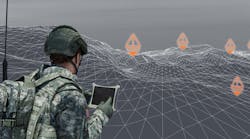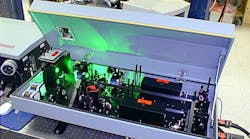Axsys to provide optical components for future Webb Telescope
Axsys Technologies Inc. in Rocky Hill, Conn., won an $18.6 million contract from Ball Aerospace and Technology Corp. in Boulder, Colo., to produce beryllium optical substrates for the James Webb Space Telescope. Axsys supplies precision optical assemblies and components for high-performance commercial, aerospace, and defense applications. The Axsys Technologies Precision Machined Products division in Cullman, Ala., is part of the team that will produce a 6.5-meter primary mirror for the Webb Telescope. The primary mirror has 18 beryllium segments. Northrop Grumman is the prime contractor for the telescope, which is due to launch in 2011, and will replace the Hubble as NASA’s premier space telescope. Axsys will provide optical substrates for an engineering development unit, 18 primary mirror segments, and support structures. For information contact Axsys at www.axsys.com.
DRS IR sensor unit achieves software-engineering milestone
The DRS Technologies Sensors & Targeting Systems unit in Anaheim and Torrance, Calif., has been appraised as compliant at Level 3 with the Software Engineering Institute’s (SEI) Capability Maturity Model (CMM). The SEI CMM rating is a prerequisite and an evaluation factor for the acquisition of military programs with significant software engineering content. The rating confirms that the company has well-defined software development processes that meet requirements for providing software for U.S. Department of Defense mission-critical and industrial applications. Originally developed by the Software Engineering Institute of Carnegie-Mellon University in Pittsburgh, the Capability Maturity Model requires a process-based approach to software development, including systems engineering, software engineering, and project management.
Bodkin Design tapped to develop hyperspectral 3-D imager
Scientists at Bodkin Design and Engineering LLC in Wellesley, Mass., are set to develop a hyperspectral three-dimensional imager for the U.S. Air Force Research Laboratory at Hanscom Air Force Base, Mass. Air Force officials are interested in hyperspectral imaging because it is an important technique for remote sensing, Bodkin officials say. A hyperspectral image combines the spatial image with spectral analysis to build a 3-D data cube. The vast amount of information in these images helps analysts detect specific materials and objects. A data cube has two dimensions of spatial data, and one dimension of wavelength. Potential applications include autonomous materials identification, chemical defense, missile defense, and homeland security. For more information contact Bodkin Design and Engineering at www.bodkindesign.com.
Kollmorgen Electro Optical to provide optical sight systems for U.S. Navy
Kollmorgen Electro Optical of Northampton, Mass., will provide five MK46 Mod 1 optical sight systems (OSS), four for the U.S. Navy’s Arleigh Burke Class destroyers and one Japan under the Foreign Military Sales Program. Kollmorgen will do the work under terms of a $6.9 million contract from the U.S. Naval Sea Systems Command. The MK46 Mod 1 optical sight system is a two-axis, gyro-stabilized, sensor with a color daylight-imaging sensor, 3-5-micro thermal imaging sensor, eye-safe laser rangefinder, and an automatic video tracker. The MK46, part of the MK34 Gun Weapon System, enables the ship’s primary gun system to use either radar or electro-optical target tracking and imaging data.


